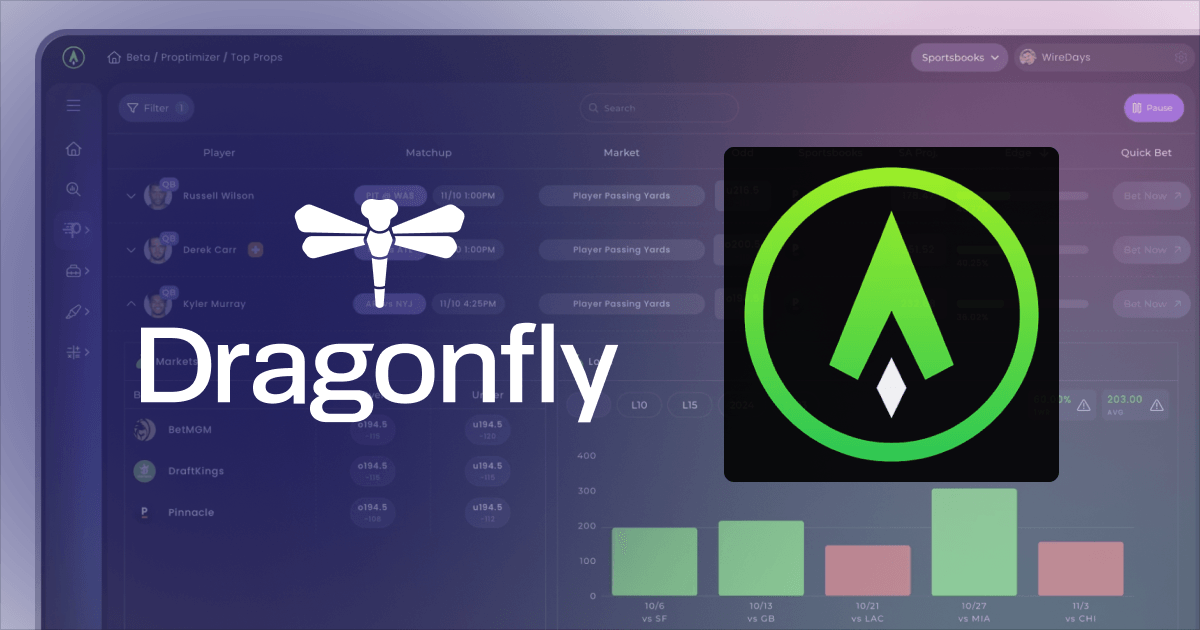Case Study: Sharp App Boosts Sports Betting with Dragonfly
Sharp App cut latency by 85% & boosted throughput with Dragonfly, replacing Redis for real-time sports betting analytics. Read their success story!
May 7, 2025

Sharp App’s High-Stakes Data Challenge
Sharp App provides sports bettors with real-time analytical tools to identify arbitrage opportunities—instances where discrepancies in odds across bookmakers allow for profits. To deliver value, the platform must process terabytes of data from sportsbooks daily while maintaining sub-second latency. Even a minor delay could mean missing a lucrative betting window.

Technical Overview
Sharp App’s infrastructure is built for speed and efficiency, processing a relentless stream of live odds data from over 120 upstream sportsbook sources. The data pipeline ingests updates via server-side events and BullMQ, ensuring seamless real-time processing, while GraphQL serves the analyzed data to end users with minimal overhead. Hosted on DigitalOcean for its cost-effective network bandwidth—a critical factor given the platform’s high-volume data demands—the system relies heavily on optimized in-memory data types. Hashes store rapidly fluctuating odds, enabling lightning-fast updates, while sorted sets power efficient market status tracking and arbitrage calculations, allowing users to identify profitable opportunities instantly.
Previous Setup: The Limitations of Redis
Before adopting Dragonfly, Sharp App used Redis with a rudimentary clustering setup. While Redis can perform well under normal loads, it struggled to maintain consistent performance under Sharp App’s demanding workload:
- Performance Bottlenecks Under Load: While Redis can achieve low latency in ideal conditions, it became a bottleneck under heavy traffic—with latency spiking to ~200 ms during peak operations, directly impacting arbitrage opportunities.
- Operational & Cost Overhead: Running multiple Redis instances created unnecessary complexity, wasting CPU resources and requiring engineering forces for maintenance rather than innovation.
- Inefficient Scaling: Redis doesn’t scale vertically. Using more powerful hardware led to diminishing returns, while clustering introduced additional operational costs without solving core performance issues.
Evaluation & Migration: Why Dragonfly Won
As Sharp App’s data demands grew, the team recognized the need for a more robust alternative to their Redis setup. They conducted a thorough evaluation of next-generation in-memory data stores, assessing each solution against their stringent performance and scalability requirements.
KeyDB initially appeared promising as a Redis fork with multi-threading capabilities, but concerns about its inactive maintenance made it unsuitable for a business-critical application. Valkey, as the emerging Redis-forked successor, offered better long-term viability but still required clustering to support the workload, which was a burden Sharp App wanted to avoid.
Dragonfly stood out by addressing both immediate and future needs. Its vertical scaling capability allowed Sharp App to consolidate workloads onto a single high-performance instance, eliminating the immediate need for clustering while preserving the option to scale horizontally later. The decision was further reinforced by Dragonfly’s reputation for exceptional throughput and sub-millisecond latency under heavy loads, all powered by its multi-threaded shared-nothing architecture, designed from the ground up.
A Seamless Migration Process
The transition to Dragonfly proved remarkably smooth. Using Dragonfly’s Kubernetes Operator, the engineering team completed the migration in under a day—a testament to Dragonfly’s compatibility with existing Redis protocols and commands. No complex data migration was required thanks to the ephemeral nature of betting data.
The team made strategic configuration adjustments to optimize performance, implementing --cluster_mode=emulated and --lock_on_hashtags server flags to ensure proper key distribution for BullMQ workloads. These minor tweaks allowed them to fully leverage Dragonfly’s capabilities without significant code changes to their application layer.
After Migration: Dragonfly’s Performance & Impact
"Let me show you the latency graph," said Ray Hughes, Co-Founder & CTO at Sharp App, pointing to the dramatic drop in response times after their Dragonfly migration. The numbers speak for themselves.

Latency after Switching to Dragonfly | One of Sharp App’s Services
Performance Gains
The migration to Dragonfly delivered immediate and measurable improvements across performance metrics, transforming Sharp App’s ability to serve time-sensitive data.
- Latency Reduction: Average response times plummeted from ~200ms to ~30ms, giving bettors critical extra milliseconds to capitalize on arbitrage opportunities.
- Throughput: As part of the system, Dragonfly now comfortably handles 800k+ ops/sec during peak betting windows, with headroom to scale beyond 1M ops/sec easily as new features launch in the near future.
- CPU Efficiency: Despite processing millions of calculations, Dragonfly’s CPU utilization remains astonishingly low at 12–13%.
Simplified Infrastructure
Beyond raw performance, Dragonfly enabled a dramatic streamlining of Sharp App’s technical infrastructure, reducing complexity while enhancing reliability.
- Consolidation: Sharp App replaced an intricate web of Redis instances with a single 48-core self-hosted Dragonfly server, slashing management complexity.
- High Availability: Two strategically placed replicas provide failover protection without introducing the headaches of sharding.
- Cost Savings: The leaner infrastructure reduced both cloud bills and engineering overhead. Engineering resources are now allocated to innovation rather than firefighting.
In Sharp App’s Own Words
Ray from Sharp App sums up the experience:
I really can’t say enough—Dragonfly exceeded my expectations. I expected to turn it on and think, okay, it’s working as advertised, but there are still load issues in this section. But there was nothing like that. I can’t explain it. The usage is low, the load is low, and everything is just wired perfectly in the system.
— Ray Hughes, Co-Founder & CTO @ Sharp App
A Clear Winner for High-Performance Real-Time Data
By migrating to Dragonfly, Sharp App achieved lower overall latency under heavy loads, higher throughput, and simplified infrastructure—all critical for real-time sports betting analytics. The platform now scales effortlessly while maintaining sub-second response times, ensuring users never miss a profitable opportunity.
About Dragonfly
Dragonfly is a high-performance, multi-threaded, in-memory data store designed for modern demanding workloads. For businesses processing high-velocity data with strict latency requirements, Dragonfly proves to be a game-changing alternative to Redis.
To try Dragonfly for free and experience performance improvements and cost savings of your own, sign up for Dragonfly Cloud.
